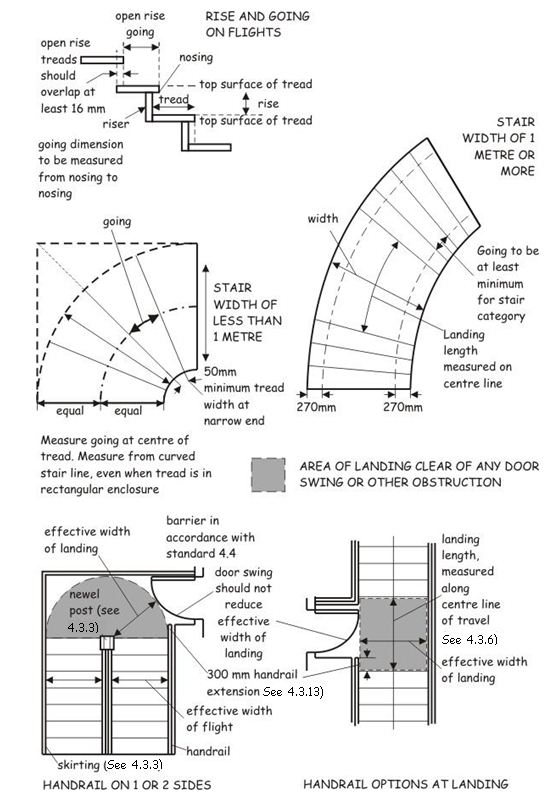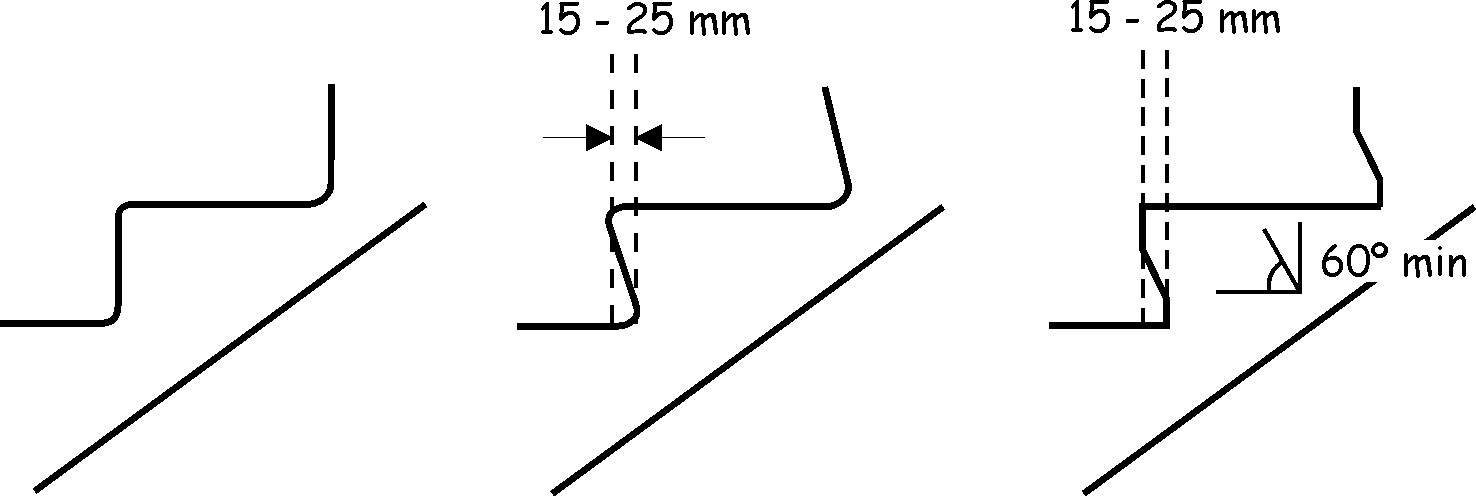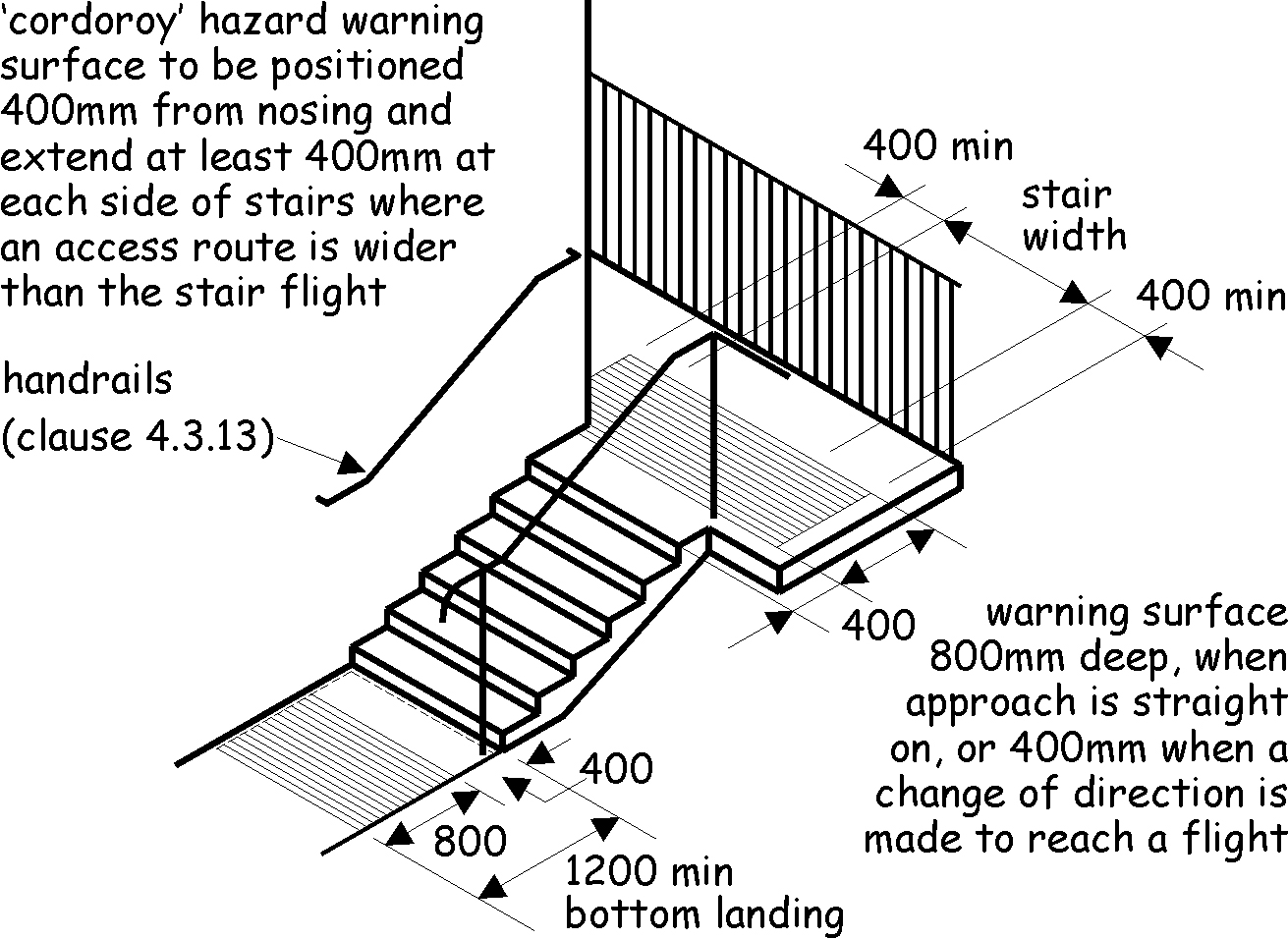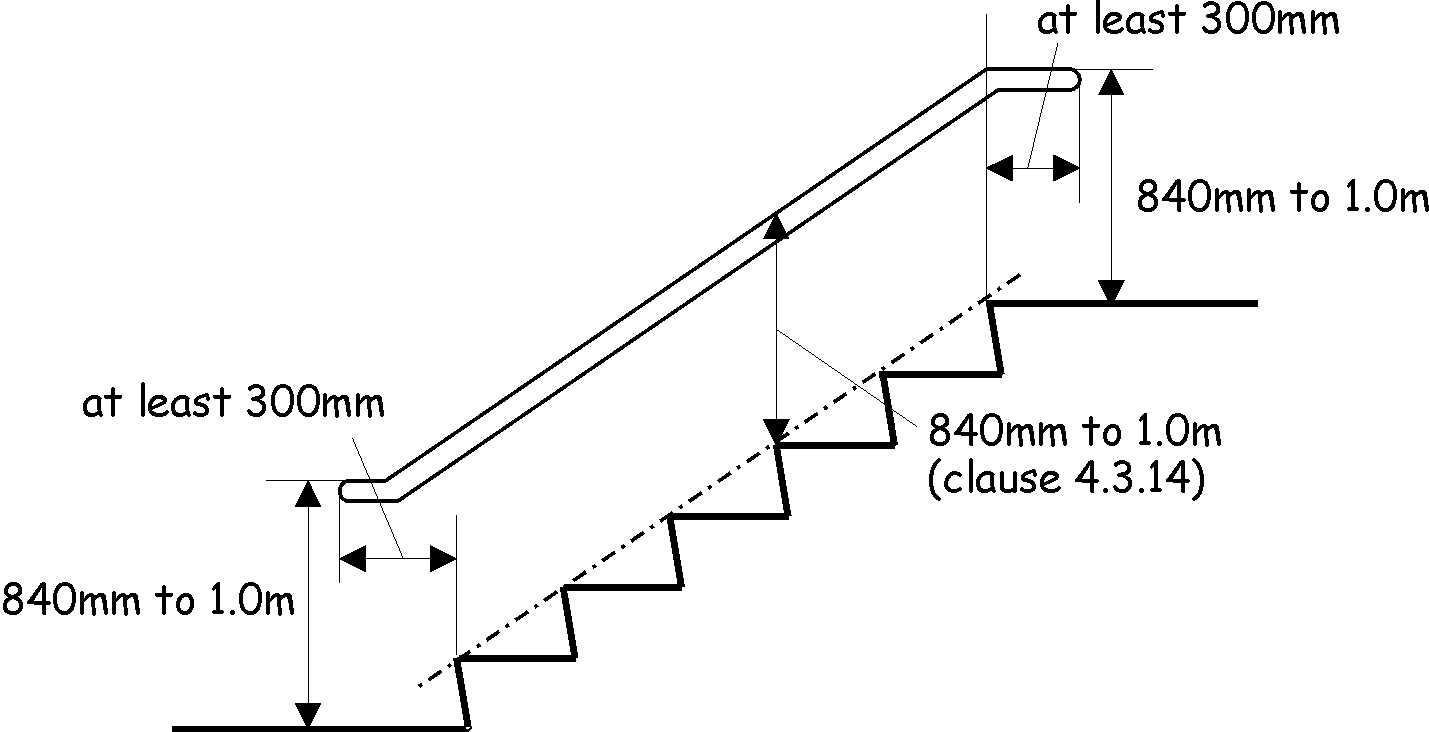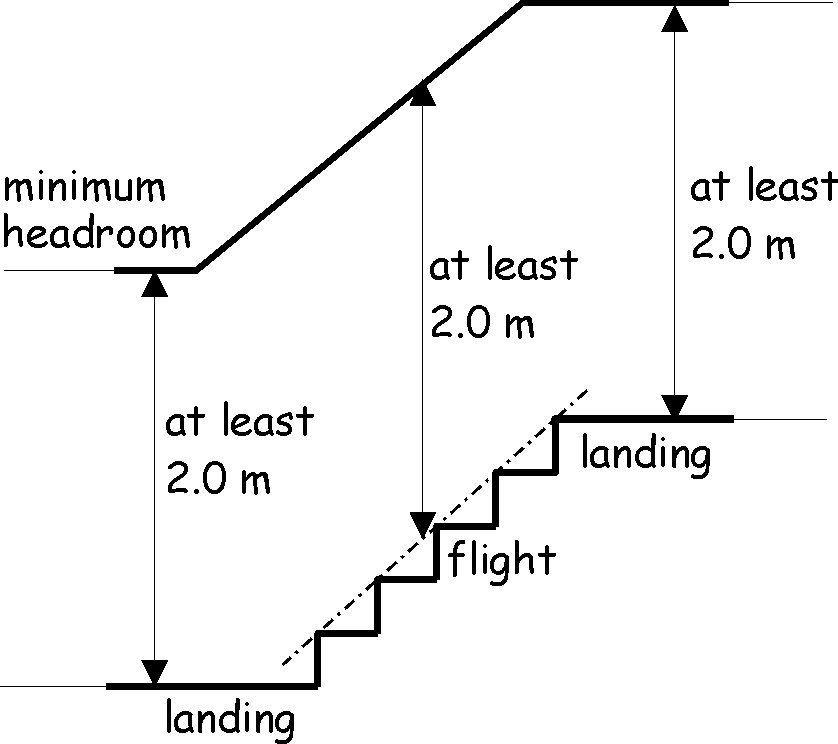4.3 Stairs and ramps
Standard 4.3
Every building must be designed and constructed in such a way that every level can be reached safely by stairs or ramps.
Half of all accidents involving falls within and around buildings occur on stairways, with young children and elderly people being particularly at risk. This risk can be greatly reduced by ensuring that any change in level incorporates basic precautions to guard against accident and falls.
Stairs and ramps should be constructed to be within limits recognised as offering safe and convenient passage and designed so that any person who is likely to use them can do so comfortably and safely, with the minimum amount of difficulty. Design should also address the issue of appropriate guarding, where a level change is made, and seek to eliminate any possible trip hazards.
Explanation of terms
The following terms are explained to provide clarity to their meaning in the Technical Handbooks.
Tapered tread means a stair tread in which the nosing is not parallel to the nosing of the tread or landing next above.
Conversions - in the case of conversions, as specified in regulation 4, the building as converted shall meet the requirements of this standard in so far as is reasonably practicable, and in no case be worse than before the conversion (regulation 12, schedule 6).
The geometry of a stair flight can have a significant effect on the ability of people to use a stair safely and conveniently and limits should be placed on the rise and going of a stair, and steepness of pitch.
To provide safe and convenient access, the rise, going, tread and pitch of a flight in a stair should be in accordance with the following table:
Table 4.2. Stair geometry - stairs to or within a building
| Minimum rise (mm) | Maximum rise (mm) | Minimum going (mm) | Tread | Maximum pitch |
|---|---|---|---|---|
| 100 | 170 | 250 | not less than going | 34º |
Additional information:
All rises in a flight should be of uniform height.
In a straight flight, or in a part of a flight that is straight, measurement should be uniform along the centreline of the flight.
Where a flight consists partly of straight and partly of tapered treads, the going of the tapered treads should be uniform and should not be less than the going of the straight treads.
The going measured at the narrow end of a tapered tread should be at least 50mm (see diagram to clause 4.3.2).
The aggregate of the going and twice the rise should be at least 550mm and not more than 700mm. For example, stairs provided with the minimum going of 250mm would result in rises of at least 150mm.
In a stair, wholly within shared residential accommodation, maximum rise may be 220mm, minimum going may be 225mm and maximum pitch may be 42º.
The most comfortable combination of rise and going varies between individuals but in general, a going in excess of the minimum, resulting in a figure in the upper end of the range in note 5 above, will increase both safety and amenity.
4.3.3 Width of stair flights and landings
The clear, or effective, width of a stair should allow users to move up and down unhindered and permit people to pass on a flight.
The effective width should be measured between handrails or, where there is no handrail present, between any walls or protective barriers. It should be clear of obstructions, as described in the diagram to clause 4.3.2. The effective width of a stair should be not less than 1.0m, or otherwise in accordance with the recommendations of the following table:
Table 4.3. Effective widths of flights and landings
| Stair wholly within shared residential accommodation | Escape stairs | Any other stair |
|---|---|---|
|
|
refer to recommendations in guidance to Standard 2.9 | not less than 1.0m |
Additional information:
The effective width of the stair within shared residential accommodation may be 800mm where a handrail is fitted to both sides of the flight.
The projection of any stringer or newel post into this width should be not more than 30mm.
The act of climbing stairs can be tiring to many people. Whilst landings can provide a safe resting point, the flight itself is not intended to do so. The maximum number of rises between landings should therefore be limited.
Generally, a flight should have not more than 16 rises.
Below a minimum number of steps, it becomes difficult to signal a change of level, which can contribute significantly to a trip hazard.
Generally, a flight should have at least 3 rises.
However people tend to take greater care at certain locations, such as at an external door, and a single step or 2 steps may be appropriate under certain circumstances. There may be less than 3 rises:
All stairs providing access to and within buildings should be designed to be accessible by most persons with reduced mobility.
Open risers on a flight can be a hazard. When ascending a stair, people may be at risk of trapping the toes of shoes beneath projecting nosings, and of tripping as a result. In addition, many may feel a sense of insecurity when looking through spaces present between treads.
A stair should have contrasting nosings to assist in identifying the position of treads and risers should be profiled to minimise tripping as shown below. Open rises should not be used unless a stair is intended for descent only, such as in a dedicated escape stair on an escape route.
However a stair within shared residential accommodation may be constructed with open risers and without contrasting nosings as occupants will be more familiar with the stair through frequent use.
Small children can climb or fall through gaps in stair treads and the size of such gaps should be limited to prevent this. In a flight with open rises, the treads should overlap by at least 15mm. Any opening between adjacent treads in a flight should be small enough to prevent the passage of a 100mm sphere.
Clear space is needed to the head and foot of any stair flight to allow people to move between a flight and an adjacent level surface safely. People may also wish to pause on stairs, particularly during ascent, and any intermediate landing should provide a temporary respite and be of a size to allow this whilst still permitting others to pass safely.
A stair landing should:
be provided at the top and bottom of every flight. A single landing may be common to 2 or more flights, and
be level except, in external locations, for any minimal crossfall necessary to prevent standing water, and
have an effective width of not less than the effective width of the stair flight it serves, and
be clear of any door swing or other obstruction.
The minimum length of a stair landing, measured on the centreline of travel, should be either 1.2m or the effective width of the stair, whichever is less. However, where on an intermediate landing, a change of direction of 90º or more occurs, the centreline length need not be measured if the effective width of the stair is maintained across the landing.
On landings to external stair flights, where tactile paving is used, the minimum length of landing should be 1.2m.
A landing need not be provided to a flight of steps between the external door of a building and the ground where:
the door is not an accessible entrance, and
the door slides or opens in a direction away from the flight, and
the rise of the flight is not more than 600mm.
A sudden and unguarded change of level on an access route can present a hazard to a person with a visual impairment. Therefore, on external access routes, tactile paving should be used to alert people to the presence of a flight of steps.
The use of ‘corduroy’ tactile paving identifies this hazard and advises users to ‘proceed with caution’. It should be provided at the head and foot of any flight of external steps, forming a strip 800mm deep, positioned 400mm from the first step edge, as noted below.
On any landing mutual to a flight of steps and a ramp, tactile paving should lie outwith the landing area of any ramp flight, to prevent possible confusion which might lead to injury.
General information on use of tactile paving, including options on intermediate landings, is given in 'Guidance on the Use of Tactile Paving Surfaces'.
4.3.8 Stair flights consisting of both straight and tapered treads
On that part of a flight consisting of tapered treads, the going of the tapered treads should be uniform and should not be less than the going of the straight treads. At the inner end of the tread, the going should be at least 50mm. Tapered treads on a stair should be constructed in accordance with BS 585: Part 1: 1989, Appendices B1 and B3, irrespective of material or whether it contains open rises. However guarding should be in accordance with the guidance in clause 4.4.3.
In a flight less than 1m wide the going should be measured at the centre line of the flight as described in clause 4.3.1. In a flight 1m wide or more the going should be measured at 2 points, 270mm from each end of the tread, as described in clause 4.3.1 and the minimum going should be at least the going of the straight treads.
Stairs formed from tapering treads, particularly where forming a spiral, can present greater difficulties in use for many people than straight flights. There should be an appropriate level of safety and amenity on such stairs, particularly where used as a primary means of access.
A flight consisting wholly of tapered treads, forming a helix or spiral, should be constructed to give safe passage. To achieve this, it should be constructed in accordance with the guidance in BS 5395: Part 2: 1984, but account should be taken of the following guidance clauses:
minimum and maximum rise should be as recommended in clause 4.3.2, and
the effective width should be as recommended in clause 4.3.3, and
the maximum number of rises on a flight should be as recommended in clause 4.3.4, and
other than on a stair within shared residential accommodation, risers and treads should be as recommended in clause 4.3.5, and
handrails should be as recommended in clauses 4.3.13 and 4.3.14, and
protective barriers should be as recommended in clause 4.4.2.
Surfaces with a gradient of 1 in 20 to not more than 1 in 12 are considered to be ramps and recommendations are made on such surfaces to ensure the safety and amenity of users. Gradients of more than 1 in 12 are considered too steep to negotiate safely and are not recommended.
Steep gradients require both greater effort to ascend and more care when descending. As a general principle, the steeper the gradient of a ramp, the shorter the flight should be. A pedestrian ramp should be constructed in accordance with the following table:
Table 4.4. Gradient, length and rise of a flight in a pedestrian ramp
| Maximum gradient of flight | Maximum length of flight | Maximum rise |
|---|---|---|
| 1 in 20 | 10m | 500mm |
| 1 in 15 | 5m | 333mm |
| 1 in 12 | 2m | 166mm |
| More than 1 in 12 | Not recommended | Not recommended |
Additional information:
The maximum flight length for a particular gradient can be interpolated as follows: 3m long for a gradient of 1 in 13, 4m long for a gradient of 1 in 14, and so on.
4.3.11 Width of ramps flights
The width of a ramp should relate to the intensity of use. For example, an unobstructed width of 1.8m is the minimum that will allow two wheelchair users to pass safely. As a ramp flight will normally be enclosed between flanking handrails or guarding, it is important that this width still offers safe and convenient passage.
The effective width of a ramp flight should be at least 1.0m. Effective width is measured between handrails, or where there are no handrails, the protective barrier or inside face of any wall or guarding kerb, and should be clear of any obstructions.
A ramp which forms part of an escape route should have an effective width of not less than 1.2m and follow the general guidance for escape route corridors given in the guidance to Standard 2.9.
Clear space is needed to the head and foot of any ramp flight to allow people to move between a flight and an adjacent level surface safely. This should permit manoeuvring of a wheelchair without obstructing passage or the need to encroach into circulation routes or onto a ramp flight.
A ramp landing should:
be provided at the top and bottom of every flight. A single landing may be common to 2 or more flights, and
be level except, in external locations, for any minimal crossfall necessary to prevent standing water, and
have an effective width not less than the effective width of the flight it serves, and
be clear of any door swing or other obstruction.
The unobstructed length of a landing should be not less than 1.5m, to allow space for wheelchairs or prams to stop after travelling down a flight and to provide manoeuvring space.
Where the entire length of a series of ramp flights is not visible from either the top or bottom landing, intermediate landings should have an effective width of not less than 1.8m, to provide passing places during ascent or descent.
Handrails to stair and ramp flights will provide support and assist safe passage. As the full width of a flight may be used, either by people passing or by a person who favours one side, a handrail should generally be provided to both sides of a stair or ramp flight.
A handrail should be provided to both sides of any flight where there is a change of level of more than 600mm, or where the flight on a ramp is longer than 2m.
The extension of a handrail at landings allows an individual to steady themselves before ascending or descending. For a person with impaired vision, the change in slope of the handrail and its return into a wall can also signal the start or finish of a flight.
A handrail on a stair or ramp flight should:
extend at least 300mm beyond the top and bottom of the flight as shown in the diagram above. However the 300mm extension may be omitted where the handrail abuts a newel post, and
have a profile and projection that will allow a firm grip, and
end in a manner, such as a scrolled or wreathed end, that will not present a risk of entrapment to users, and
contrast visually with any adjacent wall surface.
A stair or ramp that is more than 2.3m wide should be divided by a handrail, or handrails, in such a way that each section is at least 1.1m and not more than 1.8m wide. This does not apply to a stair between an entrance door to a building and ground level, unless forming part of an escape route.
A handrail should be fixed at a height of at least 840mm and not more than 1.0m, measured vertically above the pitch line of a flight on a stair or ramp and on a landing where a handrail is provided.
A flight or landing on a stair or ramp should have clear headroom of at least 2.0m extending over the whole of the effective width. Height should be measured vertically from the pitch line of the flight or from the surface of the landing.
An industrial stair or fixed ladder serving an area in any building to which only limited access is provided should be constructed so as to offer safe passage. This method of access is not for public use and would only be expected to be provided in places such as plant-rooms. A stair or ladder should be constructed in accordance with:
BS 5395: Part 3: 1985 or BS 4211: 2005, as appropriate, or
BS 5395: Part 2: 1984 where the stair is a spiral or helical stair.
4.3.17 Stairs and fixed ladders in agricultural buildings
A stair or fixed ladder in an agricultural building should offer safe passage. Such a stair or fixed ladder should be constructed in accordance with BS 5502: Part 80: 1990.
In buildings designed for assembly and entertainment, where areas of fixed seating are provided to accommodate spectators, access is commonly provided by gangways separating areas of seating.
To maintain sight lines for spectators, it is common for seating areas to be formed on a rake, either as a continuous gradient or following a rising parabolic curve. In the latter, steps following the curve may be provided if the variation in step rises is uniform within a flight.
The design of radial gangways – those running ‘at right angles’ to seating rows – should allow safe access and minimise possible hazards to users.
Where a stepped or ramped gangway provides access within an area of fixed seating, it should be in accordance with the general guidance set out in this standard. However it is not necessary to provide:
a handrail where the edge of a stepped or ramped gangway is adjacent to fixed seating or an appropriate barrier. Where the side of a gangway is remote from seating, appropriate guarding should be provided as described in clauses 4.4.1 and 4.4.2
a landing in accordance with clause 4.3.6 at the foot of a stepped gangway where this gives direct access only to fixed seating, e.g. at a balcony, and where a protective barrier is provided as described in clauses 4.4.1 and 4.4.2.
Where fixed seating is installed, intermediate steps between tiers of seating should be positioned to minimise projection of any riser into the clearway zone at the end of each row. This may result in treads of differing lengths. A regular step rhythm should be maintained in all cases.
